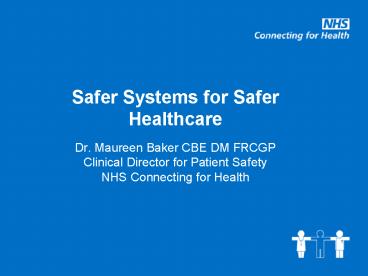Safer Systems for Safer Healthcare - PowerPoint PPT Presentation
1 / 23
Title:
Safer Systems for Safer Healthcare
Description:
Safer Systems for Safer Healthcare Dr. Maureen Baker CBE DM FRCGP Clinical Director for Patient Safety NHS Connecting for Health Overview The NHS The NPfIT ... – PowerPoint PPT presentation
Number of Views:105
Avg rating:3.0/5.0
Title: Safer Systems for Safer Healthcare
1
Safer Systems for Safer Healthcare
- Dr. Maureen Baker CBE DM FRCGP
- Clinical Director for Patient Safety
- NHS Connecting for Health
2
Overview
- The NHS
- The NPfIT
- Development of patient safety movement
- Safety management systems
- NHS CFH Clinical Safety Management System
- Experience so far
- Next steps
3
The UK National Health Service
- UK population 60 Million
- Almost 1 Million consultations with GPs every
working day - 100,000 people in hospital every working day
- NHS covers every health sector
- 4 country model
- 750 Million prescription items from general
practice in England per annum
4
The National Programme for IT in the NHS in
England
- Established 2002
- Has a number of central features and programmes
(National Spine Choose and Book GP2GP National
Care Record Service Picture Archive and
Communications Service Electronic Transfer of
Prescriptions) - Local Service Providers
- Estimated cost US25 Billion over 10 years
(contracts, training and implementation) - Being delivered by NHS Connecting for Health
5
Some definitions
- Patient Safety freedom from accidental harm
to individuals receiving healthcare - Patient Safety Incident an episode when
something goes wrong in healthcare resulting in
potential or actual harm to patients
6
NPSA Report on Safety in NPfIT
- National Patient Safety Agency established 2001
- Report commissioned 2004
- Conducted by NPSA Risk Advisor
7
Report Findings
- Not identifying safety as a benefit to drive the
programme - No formal risk assessment
- No formal safety management system
- Reliance on clinicians to instinctively address
patient safety problems - NPfIT not addressing safety in structured,
pro-active manner and other safety critical
industries would
8
Safety Critical Industries with Safety Approach
Aviation Railways Oil and Gas Construction Nuclear
Military
9
NHS CFH Clinical Safety Management System
- Based on principles of IEC 61508
- Light touch, yet robust
- Three key pieces of documentation
- Practical and pragmatic in place for almost 4
years - Supplemented by established Safety Incident
Management Process
10
NHS CFH CSMS Deliverables
- Hazard assessment
- Safety case
- Safety closure report
- Clinical Authority to Release (CATR)
- (Includes caveats)
11
What we are trying to achieve?
- Safer Care, i.e.
- x gt y ab
Risk
Baker, M et al, Safer IT in a Safer NHS Account
of a Partnership, The British Healthcare
Computing Information Management, Vol. 23 No. 7
Sept 2006
12
Safety Incident Management System
- Incidents related to Health IT reported and
logged - Assessed and managed by Clinical Safety Group
(clinicians and safety engineers) - Aim to make safe (remove potential for harm)
with 24 hours - Around 430 incidents reported since 2005
- 97 made safe within 24 hours
13
NHS IT What can go wrong?
- Patient identification (wrong notes, wrong
results, wrong procedure) - Data migration (re-start discontinued drugs,
incorrect preservation of meaning) - Data mapping (mapped to non-identical
preparation, eg long-acting or slow release) - Data corruption (over-writing of info on NHS
Spine)
14
Safety Workstreams in NHS CFH
- Safe IT systems (as safe as design and
forethought will allow) - Safety Incident Management Process
- Training for accreditation and safe
implementation - Technology for patient safety
15
Accredited Clinician Programme
- Dedicated training in principles of safety and
risk as applied to Health IT - In 4 years trained over 550 delegates, approx
60 are clinicians - Clinicians must be registered with appropriate
regulatory body - Supports clinical input to activity by
appropriately trained and qualified clinicians
16
Passing the Safety Baton
- NHS CFH (and Software Providers)
- Support from
- Clinical Safety Group
- Clinical Authority to Release
- Implementing organisation (Hospitals Pharmacists,
GPs etc.) - Support from
- Internal Risk Team
Safer Design and Development
Safer Implementation
Passing the Baton Ownership passed from NHS CFH
to NHS
17
Implementation Network
- Aimed at individuals in NHS Trusts with direct
responsibility for significant IT implementations - Develop a community of interest
- Explicitly designed to facilitate networking and
peer support - Dedicated website
- Buddying
- Could be used in support of User Standard
18
Technology for Patient Safety
- Right Patient Right Care (tracking technologies
RFID wristband datasets NHS number) - Safer prescribing (prompts alerts, tallman)
- Safer handover (core dataset)
- Electronic risk assessment tool for VTE
- Tracking of results
- Deteriorating patients
19
Design and the NHS
The NHS is seriously out of step with modern
thinking and practice with regards to design .
And also fails to understand what design thinking
can bring to an organisation . A direct
consequence of this has been a significant
incidence of avoidable risk and
error Department of Health Design Council,
Design for Patient Safety Report
20
Building a House
21
Next steps
- Focus on design and human factors for inherently
safe systems - Support implementation of standards (NHS and
international) for suppliers and users - Passing the safety baton
- Identification and safe implementation of
technology for safer care
22
National Programme for IT in NHS
The National Programme is not just an IT
programme, but a patient safety and clinical
governance programme Gordon Hextall, Chief
Operating Officer NHS Connecting for Health
23
Conclusion
- Healthcare is a safety critical industry
- IT systems dont deliver care, but are used by
clinicians in the delivery of care - Good safety practice requires proactive work
systems as safe as design and forethought will
allow - Also reactive systems to detect and manage errors
- All encompassed in CSMS and within emerging
Standards































